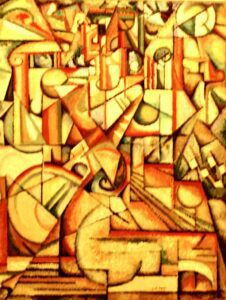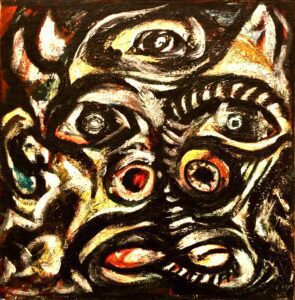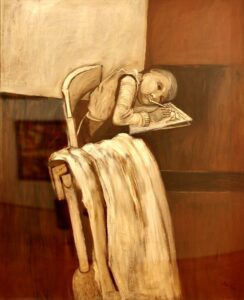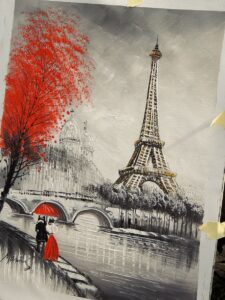The School of London was a groundbreaking movement, bringing raw emotion back to the canvas during the rise of abstract art.
It’s where artists like Francis Bacon and Lucian Freud turned the art world on its head with their bold, figurative work.
We’ll jump into the heart of this influential group, exploring how their personal experiences and relationships with the city shaped their iconic pieces.
Stick with us as we uncover the legacy of the School of London and why it still resonates in the art community today.
Origins Of The School Of London
The School of London emerged in the post-war period, a time marked by a chronicling of human experience through expressive figuration.
As filmmakers capture raw human emotions through the lens, these artists used the canvas to convey psychological depth.
During abstract expressionism’s global sway, this movement served as a powerful countercurrent – highlighting the unique experiences of city life and the complex human condition.
Key figures in this movement sought to redefine the modern art scene with works that embodied an intense personal language.
Artists like Francis Bacon and Lucian Freud stood at the forefront, igniting a dialogue within the arts that rejected the impersonal nature of prevailing artistic trends.
Their desire for an art that spoke to the visceral experiences of life itself became the cornerstone of the School of London.
- Francis Bacon – whose distorted figures and emotive use of color brought a raw, unsettling energy to the scene.
- Lucian Freud – known for his meticulous brushwork and intimate portraits that seem to penetrate beneath the skin of the subjects. Tapping into the post-war zeitgeist, these artists shared a fascination with the human form, exploring themes of isolation, despair, and identity. This focus on figurative painting was a direct response to the increasingly abstract and conceptual direction that the art world was taking. Their powerful, unapologetically realistic depictions reflected a commitment to what it meant to be human in a rapidly changing world.
Their work did not exist in a vacuum.
The cultural landscape of London – teeming with stories, struggles, and victories – served as both backdrop and muse.
The dynamic interplay between artist and city brought forth a new visual language articulated through paint – one that continues to influence filmmakers and artists across disciplines.

Key Artists Of The Movement
The School of London brought together a diverse group of painters, each with a distinct style and vision.
Francis Bacon, a tormented genius, is renowned for his emotionally raw imagery.
His masterpiece Three Studies for Figures at the Base of a Crucifixion heralded a new era of figurative art, which was both unsettling and captivating.
His bold use of color and abstraction of the human form encapsulates the existential angst of the post-war era.
Lucian Freud, celebrated for his meticulous portraiture, is another pillar of this artistic movement.
Heavily influenced by the human body, his works like Benefits Supervisor Sleeping showcased a voyeuristic intensity that brought the viewer uncomfortably close to the subject.
Freud’s dedication to realism and the psychological depth of his portraits underscored the human capacity for vulnerability and resilience.
Other notable figures include:
- Michael Andrews, whose eerie landscapes blur the lines between realism and abstraction,
- Frank Auerbach, recognized for his heavy, gestural application of paint,
- R.B. Kitaj, who infused his diverse range of subjects with a graphic intensity,
- Leon Kossoff, whose impasto techniques lent a sculptural quality to his depictions of London.
Each artist delved deep into the human condition, often using the cityscape of London as both a backdrop and a character in their narrative-driven works.
These works explore a multitude of sensations and psychological spaces, confronting viewers with the raw complexities of human nature.
Together, they forged a visual language that defied the impersonal nature of abstraction popular in their time and instead chose to narrate a more intimate human story through their art.
The Impact Of Personal Experiences
School of London artists infused their work with deeply personal experiences, resulting in a profound impact on the visual arts.
Our connection to their art stems from the raw emotions they could convey through their canvases.
Francis Bacon’s relentless introspection and Lucian Freud’s exploration of the human psyche are prime examples of art that resonates on a visceral level.

As spectators, we’re drawn into the depths of characters situated in intimate, often unsettling settings.
- Bacon’s Three Studies for Figures at the Base of a Crucifixion encapsulates existential dread,
- Freud’s Girl with a White Dog teems with tangible tension and vulnerability.
The School of London’s emphasis on the narrative aspect of art – where the story behind the brushstrokes is as compelling as the composition itself – challenges us to look beyond mere aesthetics.
We jump into the collective soul of a post-war generation through their artwork.
Their canvases served as a stage for the unfolding dramas of the time, capturing everything from desolation to desire.
This emotive approach paved the way for filmmakers and visual storytellers who also seek to embed personal and historical narratives within their work.
The fusion of personal and collective experiences has established a lasting legacy.
It’s expressed in various forms of visual media and is a testament to the enduring influence of the School of London.
Whether we’re crafting narratives in film or analyzing the intricacies of a painting, the core desire remains the same – to tell a story that resonates emotionally and intellectually with an audience.
Exploring The Relationship With The City
The School of London was as much a product of the city’s atmosphere as it was of the artists’ individual experiences.
We recognize that the gritty and resilient spirit of post-war London was a canvas unto itself for these artists.
Streets lined with the echoes of the Blitz and the solitary figures that wandered them became the unspoken backdrop for masterpieces like Three Studies for Figures at the Base of a Crucifixion.
The city’s raw textures and somber mood are vividly mirrored in the paint strokes on canvas.
It’s not just the visual aesthetics of London that influenced the School of London, but also its role as a haven for diverse communities and ideologies.
We’ve seen how this convergence of cultures and the city’s history of resilience provided a rich tapestry of narratives for artists.
From Lucian Freud’s depictions of introspective sitters to Frank Auerbach’s vigorous representations of the cityscape, London’s multifaceted character was a consistent source of inspiration.
The city served as an anchor and a muse for their creativity – a testament to the inseparable bond between the artist and their city.
- How the city informed the artists’ work ethic and output – Shared post-war experiences and rebuilding efforts – The emergence of a distinctive artistry forged in adversity.
London was not just a geographical location; it was a living being that interacted with its artists, demanding their attention and shaping their creative outlook.
As filmmakers, we too draw from the environs we inhabit.
The School of London artists taught us the importance of listening to our surroundings – the city’s whispers often hold the keys to the most profound storytelling.

The Legacy Of The School Of London
The School of London’s influence on art history cannot be overstated.
This group of artists reignited interest in figurative painting at a time when abstract and conceptual art were dominating the scene.
Their dedication to capturing the human condition through their work has left an indelible mark that continues to inspire and challenge artists globally.
By valuing personal and emotive expression, the School of London set the stage for a new era of storytelling in visual arts.
Their legacy is evident not only in paintings but in the way we approach other forms of narrative art.
Filmmakers and playwrights alike draw upon the depth and complexity of human experiences that these artists portrayed so vividly.
It’s no exaggeration to say that the raw emotional power found in films like I, Daniel Blake or plays like Jerusalem owes a great deal to the path forged by the School of London.
- Trailblazers for New Generations – artists such as Francis Bacon and Lucian Freud became role models for successive generations seeking to explore and express the intricacies of human psychology through art.
- Influence on Visual Narratives – The school’s focus on the figure led to an enriched portrayal of character, motivation, and backdrop in film and theatrical productions.
- Educational Impact – Art curricula around the world integrate the practices and philosophies of the School, advocating for a balance between technique and emotional authenticity.
The resonance of the School of London’s work is not confined to aesthetics—it also challenges viewers to engage with art on a deeply personal level.
The urgent, often uncomfortable introspection their art provokes continues to make it relevant in contemporary discussions about identity and society.
It’s essential for us in the filmmaking community to appreciate this legacy and consider how it informs the stories we choose to tell and the methods we employ to tell them.
What Is School Of London In Art – Wrap Up
We’ve seen how the School of London has left an indelible mark on the art world.
These artists have not only shaped the way we view figurative painting but have also influenced the broader narrative landscape.
Their works continue to inspire and challenge us, inviting deep personal engagement and reflection.
As their legacy lives on in classrooms and studios around the globe, we’re reminded of the power of art to jump into the human psyche and reflect the complexities of our society.
The School of London’s story is far from over, as their timeless impact encourages new generations to keep the conversation about art and humanity vibrant and evolving.
Frequently Asked Questions
Who Are The School Of London Artists?
The School of London refers to a group of artists that emerged in the mid-20th century, known for their dedication to figurative painting.
Notable members include Francis Bacon and Lucian Freud.
What Is The School Of London Known For?
The School of London is known for its profound influence on the visual arts, particularly in capturing the human condition and revitalizing interest in figurative painting as a narrative medium.
How Did The School Of London Influence Other Narrative Arts?
The impact of the School of London extended to other narrative arts such as film and theater through its focus on human psychology and storytelling.
What Is The Legacy Of The School Of London Artists In Education?
The legacy of the School of London artists in education involves the incorporation of their artistic practices and philosophies into art curricula worldwide.
Why Is The Work Of The School Of London Artists Still Relevant Today?
The work of the School of London artists is still relevant today due to its enduring challenge to viewers to engage with art on a personal level and its contribution to contemporary discussions about identity and society.



